| Columns Retired Columns & Blogs |
The Ruel reminds me a bit of the Dali Megaline. And are the drivers slot-loaded, or do they fire through an acoustic lens, or...?
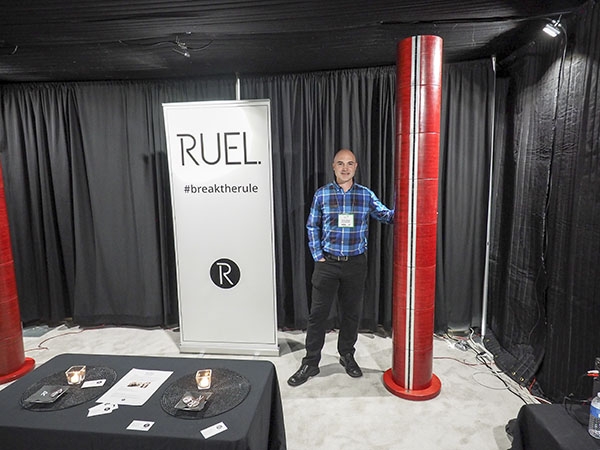
It's a very interesting, innovative speaker, with sound that, given the TAVES venue acoustics, was more than promising. The R7 has 56 drivers in each speaker, and includes a class-D amplifier and digital signal processing. The construction is modular, with each module including a connector that allows the speaker to be being plugged into the module below, with no wiring. The modular construction also means that the speaker is available in various heights, from 8' (the demoed model, $CAD40,000/pair), with modules optionally added to produce a speaker that's 12' tall, at $56,000. It's quite ingenious. The inventor, Thierry Ruel, seen in the photo, has a background in music as well as electrical engineering. The factory is in Moncton, New Brunswick, Canada.
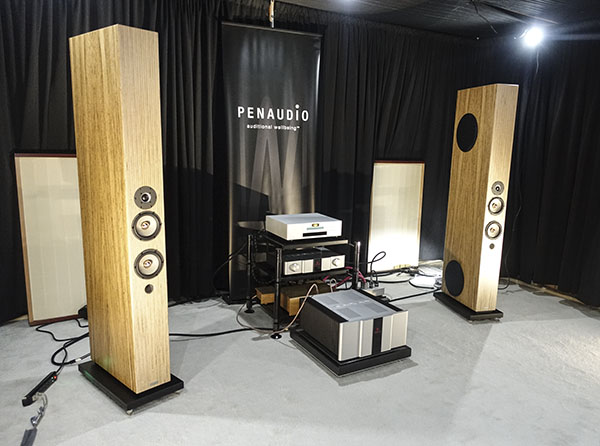
Another slim-and-tall speaker at TAVES was the Penaudio Sinfonia ($CAD33,000/pair), imported by Wynn Audio. These Made-in-Finland beauties gave a good account of themselves with a recording of Placido Domingo singing "Vesti La Giubba," Placido's voice ringing out in its stentorian power. The system included a $CAD40K Goldmund CD player and $40k Karan amplifier—not quite in the price range of Wynn's "million dollar system" at last year's TAVES, but not exactly chump change, either.
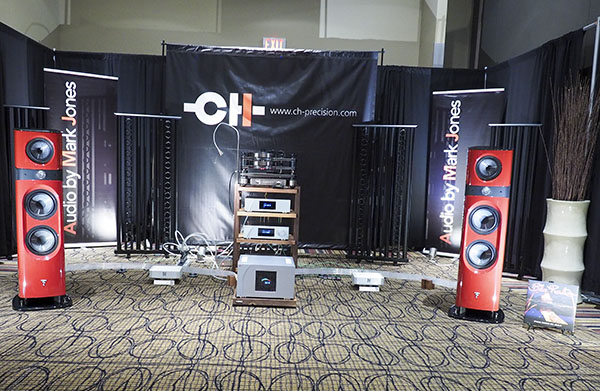
Toronto retailer Audio by Mark Jones has achieved notable success with their by-appointment-only approach. Their past participation in TAVES has been classy and professional, which was true at TAVES 2017 as well, with a the system built around FOCAL Sopra No.3 loudspeakers ($CAD24,000/pair). As well as playing music—which the system did very well—they also scheduled hourly demonstrations/comparisons of the effect of Nordost's Qkore grounding system. Jason Victor Serinus wrote about this in his RMAF show report. I have little to add to Jason's observations, except I was intrigued by Nordost's claim that proper grounding has to include DC as well as AC, the DC ground involving connecting the Nordost grounding wire to any unused input or output. At TAVES, they did a comparison of (a) AC grounding (b) DC grounding, (c) both, and (neither). Making judgements under show conditions is always problematic, but it did seem to me that while the sound (a brief excerpt from a recording by Leonard Cohen) had greater clarity and focus when both AC and DC grounding were used, DC grounding made a greater contribution to this than AC.
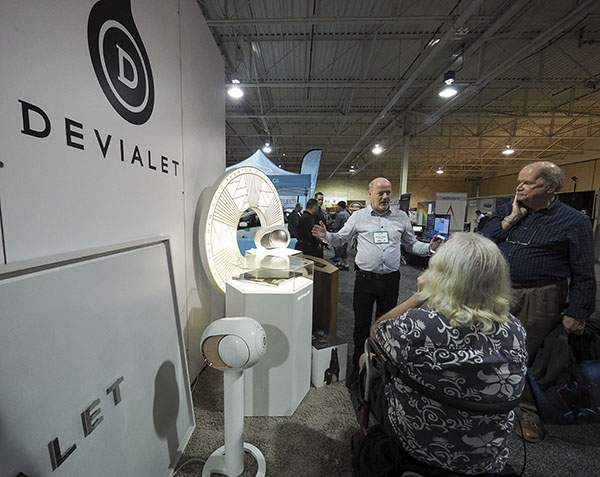
Plurison is distributor for a wide range of audio products; at this year's TAVES their participation was more modest than in past such events, being restricted to the Booths area, with most of the attention focused on the Devialet Phantom Gold wireless speaker, $CAD3995 each. (The November issue has a fascinating story by Jim Austin about spending time in Paris with the Phantom Gold and going to the opera. The poor boy. . .) Plurison's Michel Plante can be seen in the middle of the photo above, trying to explain some of the extravagant claims ("Best Sound in the World") made for this product.
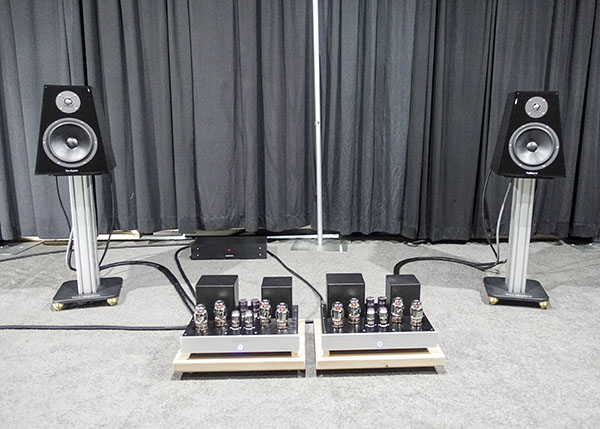
"Von Gaylord" may not be the first name that occurs to you if you're looking for a loudspeaker in the $5k range, but perhaps it should be. "A contender," is what I wrote in my little notebook, listening through the Von Gaylord VG-8 ($USD4995/pair) driven by Nirvana triode monoblocks (140Wpc, $USD8495/pair), with a Harmony Preamp ($US12,995) and Uni DA DAC ($12,995). Holly Cole singing "The Tennessee Waltz" sounded sweet and altogether easy-on-the ears. Yes, a definite contender.
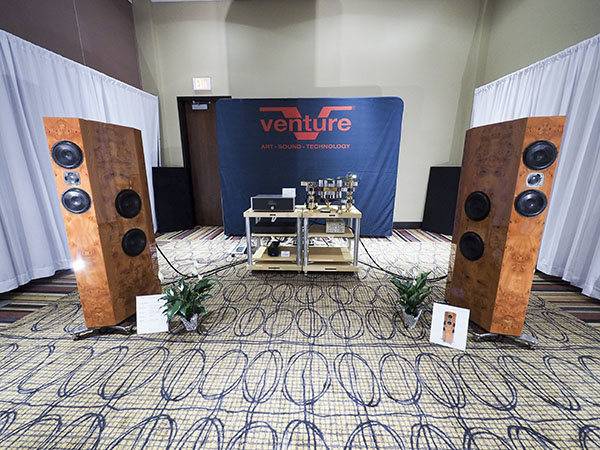
Part of the appeal of shows like TAVES is to be able to see and listen to products that are affordable for only a minute percentage of the population. The Venture Quantum Signature active loudspeaker ($USD150,000,) in a system with VP200D preamp/DAC ($USD60,000), VP100R phono stage ($USD32,000), Triangle Art Master Reference turntable ($US39,900) falls into this category (photo above).
"Does anyone buy this stuff?" is my usual thought when I encounter a system like this. But I know that the answer is "Yes," otherwise the manufacturer could not stay in business. Venture Audio, based in Belgium and Singapore, has been in business since 1986, so they must be doing something right. Venture's loudspeakers include five lines, the Quantum Signature being the most expensive, so they don't have to rely on sales of the Quantum Signature to survive. Still, Venture should be commended for bringing these speakers to TAVES, knowing full well that it's unlikely to result in a direct sale. (There was no hand-written "Show Demo Special" sign on the speakers.)
How did they sound? Considering the less-than-optimal acoustics of the venue, superb, with the sort of clarity and effortless dynamics that are expected at this exalted price level.
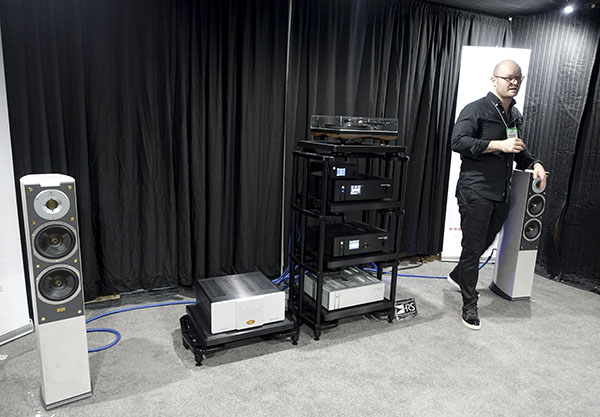
Actors' Equity "prohibits the issuing of a professional name that is identical (or similar sounding) to that of an already-current member of the union." It was this prohibition that prevented young Joseph Lane from using his own name, there already being an actor by that name. The professional name he chose was Nathan Lane, which is how we know this gifted thespian.
There is apparently no similar regulation in the audio business, which is why we can have Avantgarde Acoustics, German manufacturer of horn loudspeakers, and "Avantgarde" as part of the model designation of speakers from the Danish manufacturer, Audiovector. The speaker demoed at TAVES was the S3 Avantgarde Arrete Raw Surface Limited Edition ($CAD15,000/pair). In a system with Goldnote electronics, aided and abetted by Synergistic Research power line conditioners, this speakers impressed me as a highly sophisticated design, tonally neutral and sonically transparent.
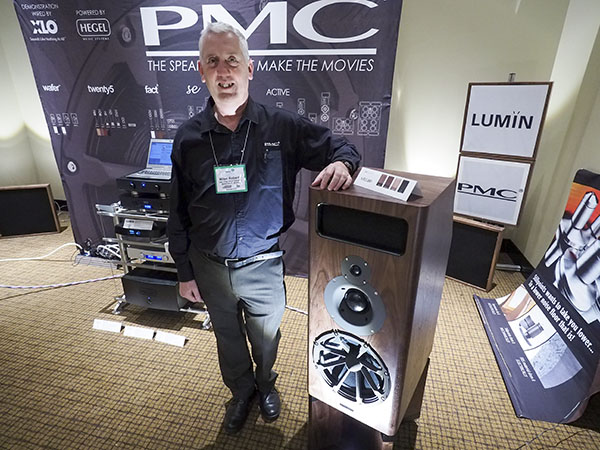
PMC speakers are widely used in professional (studio) settings--not surprising, given that the company's full name is The Professional Monitor Company, However, for various reasons, they have not made comparable inroads in home (audiophile) markets. According PMC's Miles Roberts, shown in the photo leaning on the $CAD40,800/pair PMC MB2se, PMC is working now to change that. Their speakers certainly look like they mean business, and, as far as I could tell in a very brief listen, the system, with Hegel electronics, sounded fine.
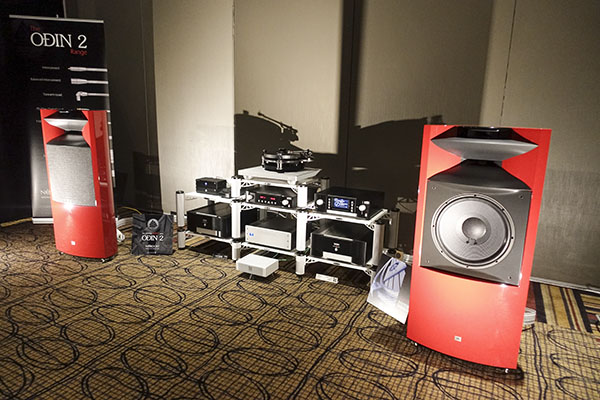
Like PMC, JBL is a speaker company with deep professional roots, but they've been an important player in the home market as well, going back to the best-selling L-100 in the 1970's., Even earlier was the JBL Paragon, a one-piece stereo loudspeaker that I remember lusting after many years ago.
The JBL speaker demoed at TAVES was the K2 S9900 ($CAN80,000/pair) in Ferrari Red. I'm not a fan of ultra-expensive speakers (perhaps because I can't afford them), but, listening to the K2 S9900s, playing a recording by Melody Gardot, I thought that, for those who have the money, this one might be actually worth it. The sound was absolutely effortless, but without the colorations that tend to plague high-sensitivity speakers. Of course, the system, assembled by Audio Eden's Mark Hamelin, was topnotch as well: Mark Levinson electronics, SME table and arm, Nordost Odin 2 cables, etc., with a total price of about $200k exclusive of speakers.
Now, let's see . . . if I buy a Honda Civic rather than a Ferrari 488 I'll have saved enough right there . . .

The Ruel reminds me a bit of the Dali Megaline. And are the drivers slot-loaded, or do they fire through an acoustic lens, or...?

Line source loudspeakers are the opposite of point source loud speakers. Even at a distance they can never sound coherent.

Hi bilguana, thank you for your comment!
You are right and I really like to talk about this :)
A line source composed of an array of drivers is designed to be coherent up to a certain frequency.
Comb-filtering occurs if you go higher than this frequency.
This frequency is determined by the spacing of the drivers.
The closer they are the better.
The R7 use closely spaced small drivers to create a true line source.
#breaktherule :)